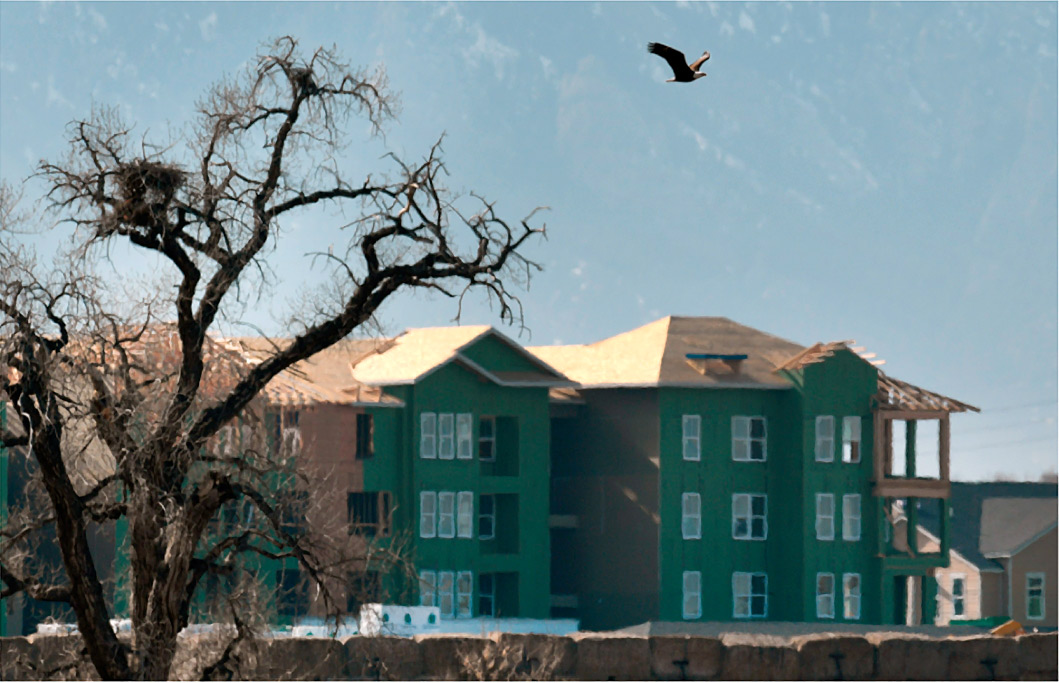FRNBES Files Two Federal Lawsuits to Protect Eagles
November 30, 2019

The Denver Post: March 10, 2019: A Bald Eagle takes off from its perch as a new housing development creeps closer to the cottonwood trees where its nest is tucked away on Boulder County open space on Feb. 26, 2019, in Broomfield. Federal law protects eagles, but as human development encroaches on nests along the Front Range, wildlife experts say local land use decision-making will be key to their survival. The pair of Bald Eagles nest year round.
FRNBES filed two federal lawsuits versus U.S. Fish and Wildlife Service regarding permitted allowances for a construction company to build a large apartment complex in close proximity to an active Bald Eagle nest (the Stearns nest in Broomfield, Colorado).
An article featured on 9News Website (August 3, 2018) elaborated on the serious problems these eagles face due to the apartment construction project.
The “incidental” take permit issued by USFW allowed the disturbance, lack of productivity or abandonment of the eagle nest—normally a federal crime of the Bald and Golden Eagle Protection Act (BGEPA). The “incidental take permit” issued by USFW gave the construction company immunity from federal penalty or punishment, which would normally result if the nesting eagles were harmed.
USFW issued a similar permit to another residential developer in 2013 to 2014, whose activities likely caused the Broomfield Eagles to suffer a catastrophic nest failure. In the week following the death of the nestling eagles–likely due to diminished brooding by the adults–the Stearns eagles abandoned their nest and began a building a new nest ¾ miles from their original nest tree. The first 2018 USFW “take” permit that FRNBES challenged was no less perilous than the 2013 to 2014 permit, as it authorized construction as close as 540 feet from the nest.
These inconsequential buffers are meaningless in an area like the Colorado Front Range, where sight lines can be well over a mile. We argued that USFW’s buffer distance of 540 ft, which was based on old timber sale studies in northern boreal forests, where sight lines were obstructed at close range due to dense vegetation, were without merit. In fact, science-based studies by Colorado Parks and Wildlife (CPW), strongly recommend a buffer from human encroachment of ½ mile (2640 feet) to keep federally protected nesting eagles from disturbance.
FRNBES and our attorneys reveled momentarily in the substantive win (no-fault written agreement) of our initial lawsuit. As a result—for the first time since the issuance of the New Eagle Rule in 2016–USFW was forced to fulfill its legal requirements for a nest-related eagle take permit, which now entailed a public announcement and comment period, and a required Environmental Assessment (EA). Once the public comments were received and the environmental assessment completed, USFW issued yet another permit, in essence dismissing 497 out of 500 public comments that opposed the permit.
USFW issued the second incidental take permit on the Stearns eagle nest to the same construction company. The new permit once again absolved the developers from any wrong doing if they disturbed or displaced the Stearns eagles. In that case, FRNBES vs U.S. Fish and Wildlife Service, 353F. Supp. 3d 1115 (D. Colo. 2018) we overturned the granted incidental take permit for the construction project. While we initially had hoped that the developer would abandon the project if the permit was voided, over a year had passed for the judge’s decision. Too much money and resources had been spent on the apartment complex, and the developer was undoubtedly confident that even if they disturbed the eagles, it would be unlikely if USFW would ever prosecute the offense. Unfortunately, while we set ground-breaking precedent by winning several critical phases of our lawsuit, the construction continued.
While FRNBES was proud of this important legal victory, it ultimately was not enough to protect the Stearns nesting eagles from the 1,000 cuts they have endured since 2013. After being in their well-loved old growth cottonwood nest tree since at least 2009, the Stearns nesting eagles finally left their home this fall of 2019. FRNBES has behavioral data from our studies that document important changes through time brought on by last two years of noisy and ongoing construction activity. Due the dearth of substantial old-growth cottonwoods in their near-nest territory for nesting building, the eagles chosen to nest in a nearly dead and fragile old growth cottonwood about ¾ miles from their original nest tree. While their new nest lies in protected and conserved “open space” land, the fragile and nearly lifeless tree is lacking the good support structure or crotch required to keep a nest long in place with the strong Colorado winds. Please check in on the our section on…..(link to examples different nest takes) to learn more about the history and current nest situation for the Stearns Bald Eagles.
